The Disney animated feature Encanto introduces movie audiences to the Madrigals, a Colombian family whose many generations live together in a magical house. When the magic begins to fail it is up to Mirabel (Stephanie Beatriz) – the only member of the Madrigals who lacks a special gift – to uncover the hidden secrets that will allow her to reforge the bonds holding her family together.
“Inspired by the magical realism that infuses much of Colombian literature, Encanto is a visual spectacle from the very beginning,” said Erin Ramos, head of effects animation at Walt Disney Animation Studios. “From Abuela’s candle whose magic ebbs and flows, to the ultimate destruction of the Madrigal family’s beloved Casita, the effects in Encanto were a visual representation of the strengths and weaknesses of the family’s bond.”
The fracturing of the family manifests itself literally in the fracturing of the house. As the tension increases so the cracks in the structure grow, culminating in the dramatic collapse of Casa Madrigal. The Disney effects team worked closely with the studio’s layout team to choreograph the timing and the pattern of the cracks. “We added a new fracture-aware subdivision algorithm to our proprietary renderer, Hyperion,” said head of effects animation David Hutchins. “This sped up iterations and increased flexibility by allowing us to art-direct rigid-body simulations.”
Each member of the Madrigal family possesses a different magical ability – for example, Bruno can see into the future, Isabela has the ability to conjure up plants and flowers at will, while Pepa’s mercurial temperament affects the weather. The Disney team explored a unique visual solution to communicate each character’s special powers. “Bruno’s visions come to him in a swirling maelstrom of sand and emerald particulate,” explained Hutchins. “For Isabela, we created procedural growth rigs and Vellum interaction rigs for each plant species. With Pepa, we had clouds, rain, hail, and even tornadoes following her wherever she goes.”
“There is also the magic of the Encanto itself,” added Erin Ramos, “which is found around the candle, the doors, and in the creation of the house. For that we developed an effect which we dubbed ‘fauxkeh’ – it became the primary shape language for the magic in our film.”
A New Pipeline
Encanto was the first production within the studio to be completed using a new Disney pipeline built on top of Pixar’s Universal Scene Description (USD) format, development of which had started during the production of Raya and the Last Dragon. “We were fortunate that the transition to USD happened to be at the same time that SideFX released the public beta of Solaris in Houdini 17.5,” said effects supervisor Christopher Hendryx. “This gave us time during Encanto’s pre-production to explore the possibilities of this new working context, before attempting to design our own tools to handle importing and exporting USD within Houdini.”
The Disney team quickly found the Solaris interface to be an intuitive way for both artists and developers to author and inspect USD data. “It was the only off-the-shelf DCC at the time to have a toolset for interacting with this relatively new format,” noted Hendryx, “so it became the preferred application for the prototyping of example datasets which we used to test pipeline concepts and proposals as they were being designed. After several weeks of testing, we found we needed very little custom development in order to integrate Solaris with our new pipeline for the effects department. We used standard LOP nodes for the majority of workflow tasks, and what little pipeline-specific integration remained could easily be handled by Python LOPs.”
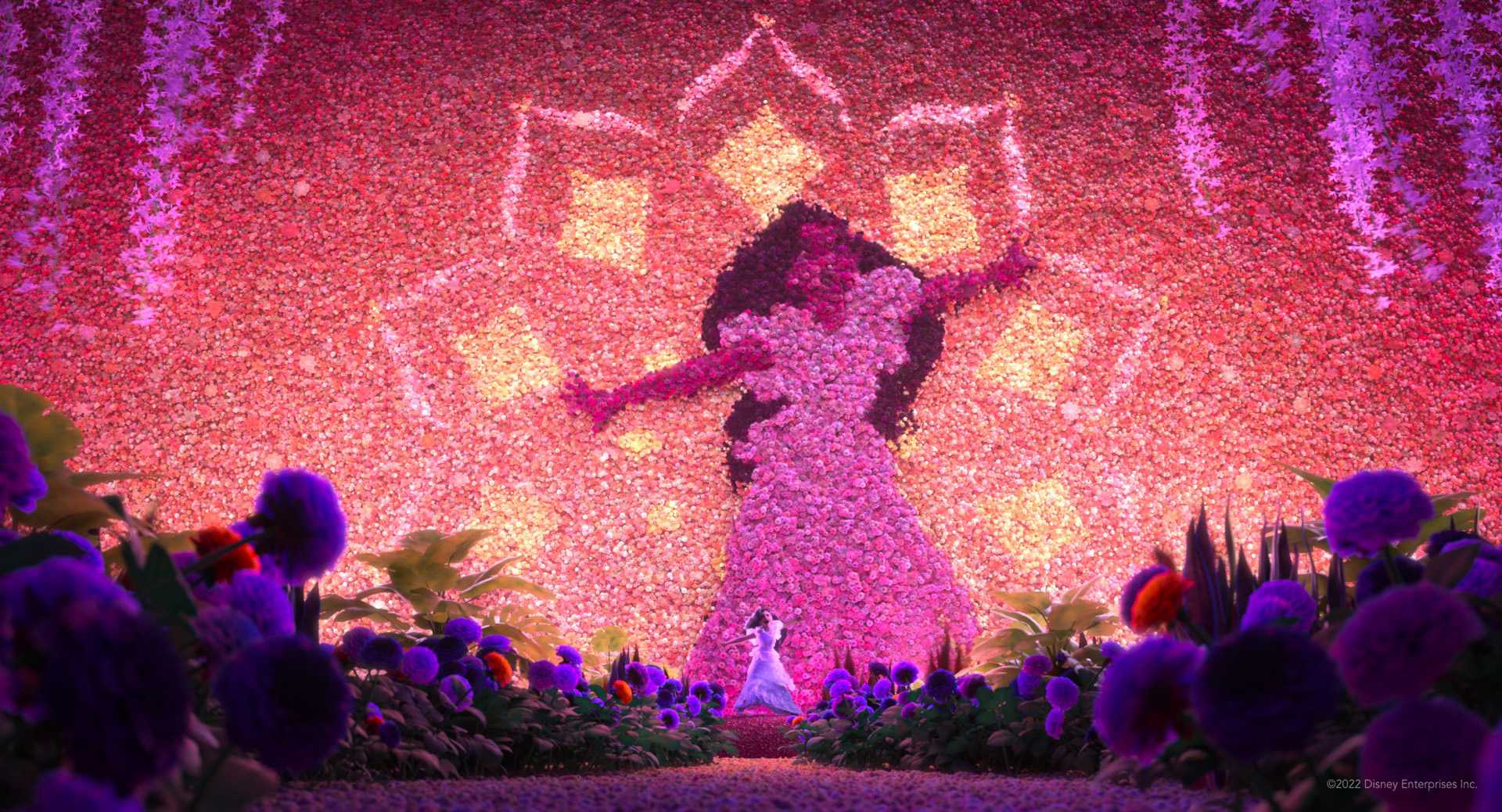
For the effects department specifically, the new pipeline opened up an entirely new set of workflows that had not previously been possible. “With all pipeline data structures represented in USD and with LOPs in our hands,” commented Hendryx, “we were able to procedurally create and edit anything within a scene. Prior to Solaris our workflow was split between Houdini and an in-house application – we would edit geometry in Houdini and use the in-house application for asset, scene and render management. With Solaris we could do everything within a single procedural interface. This unlocked workflows that were previously impossible without a hefty investment in custom tooling.”
Any transition to a new pipeline can be a lengthy and difficult process, and Disney’s transition to a USD-based system was no exception. However, the effects department soon found themselves reaping the rewards. “As we continue forward with the tool and pick-up improvements with every new version of Houdini,” concluded Hendryx, “we see new workflows and potential being unlocked on every production.”
The Pepa Cloud
When tackling the weather effects that accompany Pepa, the Disney effects team looked for ways not only to express Pepa’s ever-changing moods, but also to externalize her powers in a playful and engaging way. The primary expression of her gift became known as the ‘Pepa Cloud.’ “It was very important that the effect did not just look like a cloud scaled down to Pepa’s size,” said effects lead Dimitre Berberov. “The cloud really had to complement the scale of the characters and also the environment, fitting into the surroundings while still retaining some of familiar features we associate with the phenomenon.”
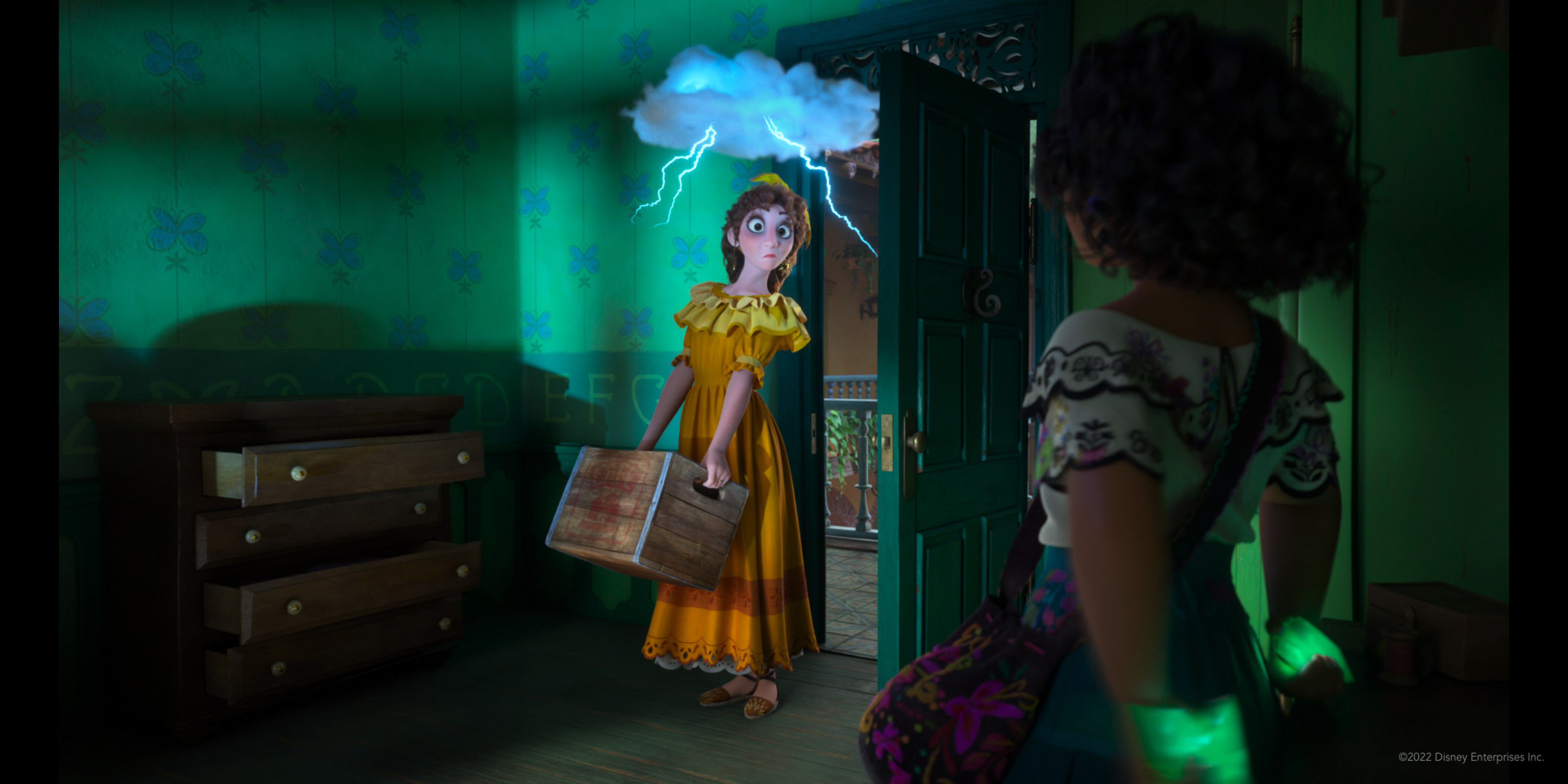
Artists modeled the cloud via DOPs, using the gas dissipate, turbulence and disturbance features to push and pull the volume to create the desired effect. “Once the main shape was created,” Berberov explained, “we further enhanced the motion by using a custom volume lattice SOP to deform the cloud. This gave us classic squash and stretch behavior to compliment Pepa’s movements.”
Isabela's Flowers
The environments of Encanto are replete with dense growths of lush vegetation, created in Houdini using a range of Vellum rigs. “We built well over 15 different simulation rigs,” said effects lead Jake Rice, “one for each plant type that needed to be animated or interacted with. The bulk of our time was spent building curve and geometry networks to simplify the geometry for faster simulations
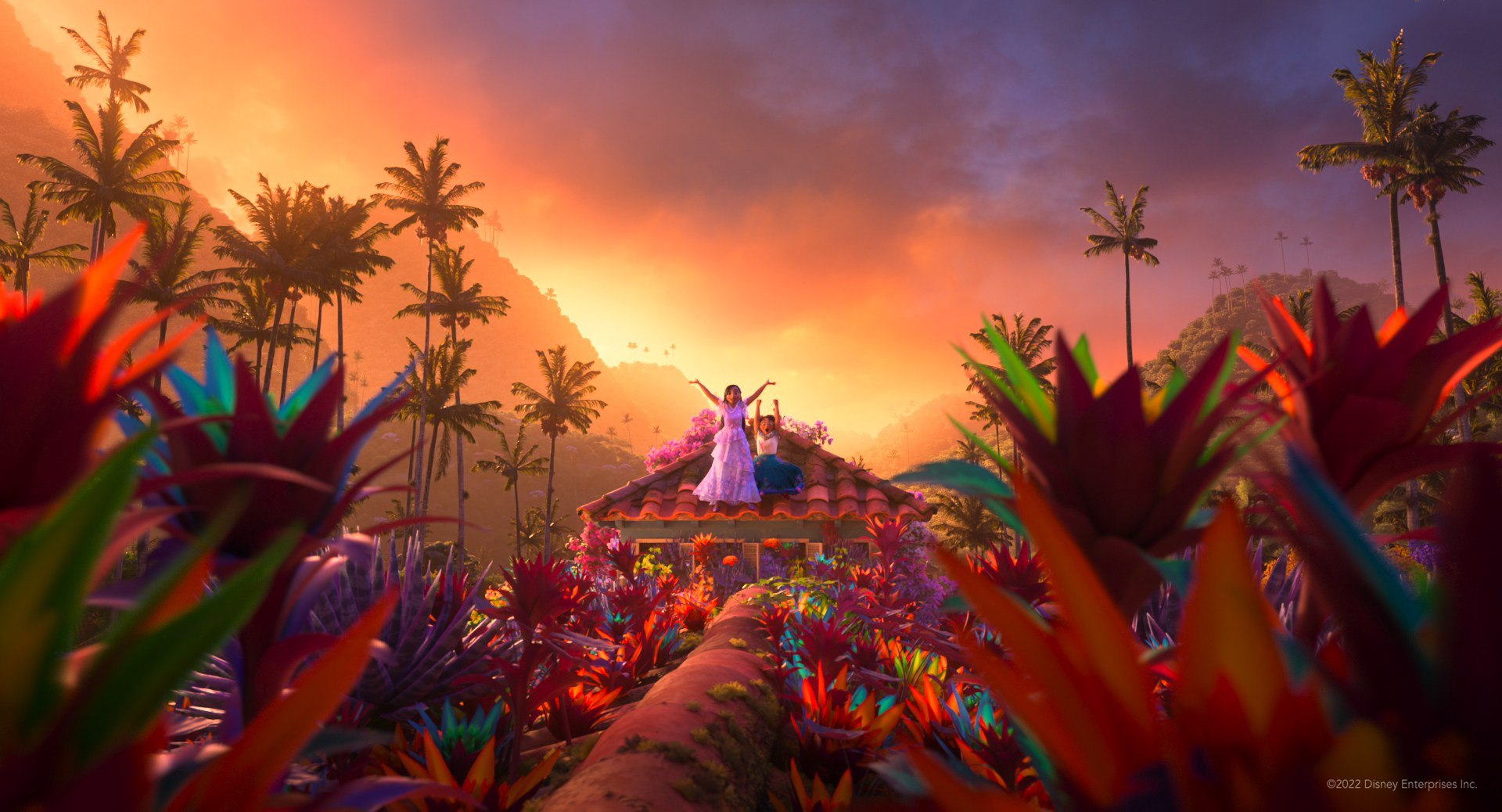
For vegetation requiring hero animation – such as the flowering plants that grow during Isabela’s song What Else Can I Do? – artists generated highly animatable SOPs rigs. “The plant animation needed to convey the power and elegance of Isabela’s gift,” Rice observed, “so we opted for methods that gave us as much control as possible, which meant avoiding any kind of simulation until the last possible moment. To drive the plant motion we relied on KineFX-style SOPs rigs on curve networks – this gave us the control we needed. We developed a modified point deformer that made the difficult process of binding geometry to curves as efficient and reliable as binding to polygonal geometry. Finally, on hero-animated plants, we passed the results through either CHOPs or Vellum to get overlapping motion on the final animation. From here it was mainly a game of syncing up the flower growth to the music hits, to bring the whole song to life through the animated environment.”
Bruno’s Visions
During Bruno’s visions, images of the future materialize from a swirling tornado of glowing green sand. The Disney effects team created the base motion using a shallow FLIP simulation. “We used a high number of sub-steps in order to resolve the various interacting forces in an appealing way,” said effects lead Alex Moaveni. “The forces came from a volume gradient generated using the luminance value in a reference image. Higher luminance values translated into stronger divergent forces.” Artists created the underlying reference image using SOP ‘fake’ geometry lighting tools written in VEX.
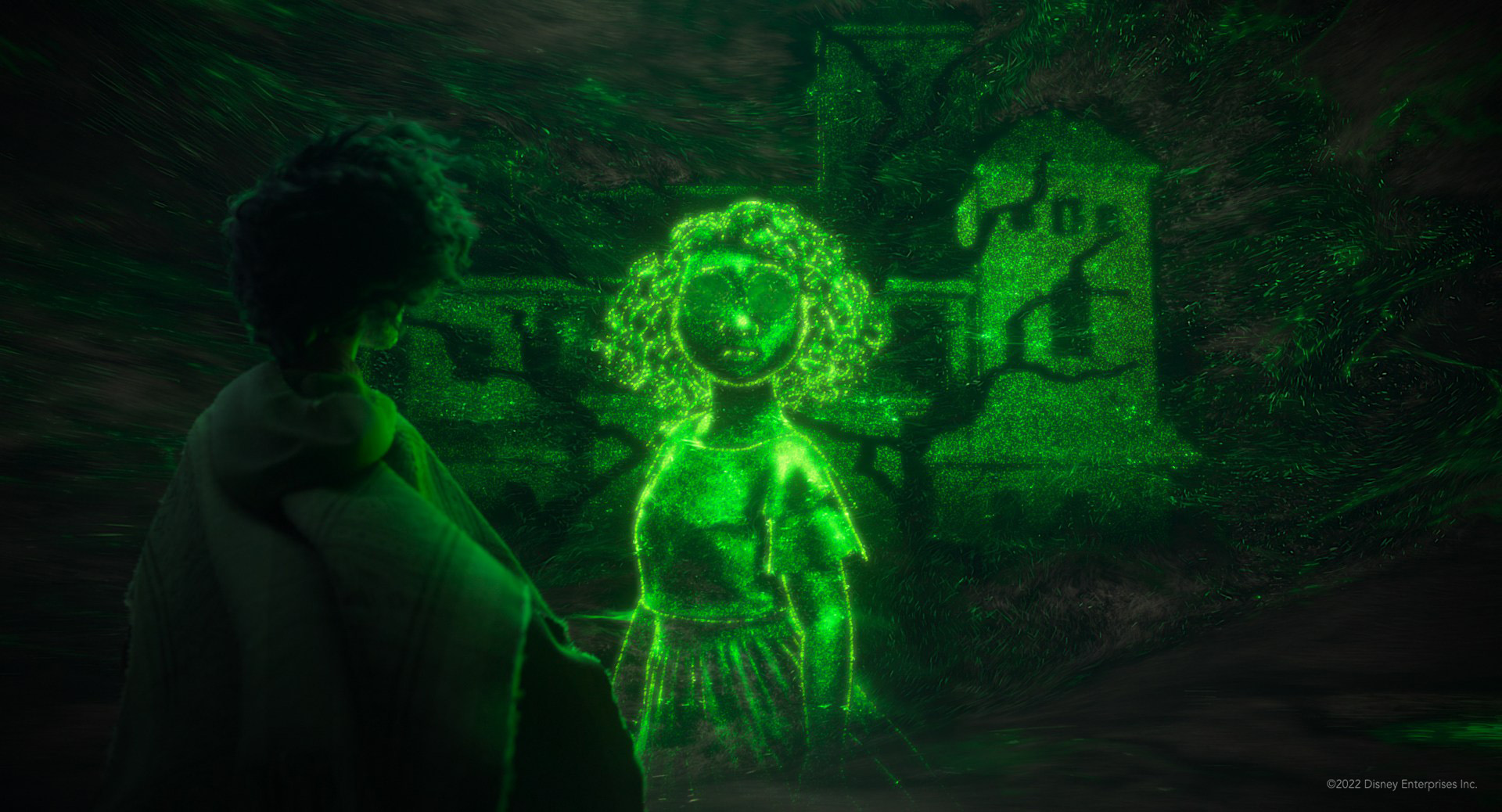
“We used a SOP solver to add more attractor or repeller forces to keep the green particles clumped together and separated from the tangent akin to an oil and water effect,” Moaveni elaborated, “The shallow FLIP was solved in UVW space – we used this to map onto a parametric dome representing the worldspace position. We employed a variety of post-sim attribute transfer and SOP solver techniques to touch up the vision read and add complementing flourishes.”
Cracking the House
Casa Madrigal is a character with its own unique personality and the cracks that run through the house serve as important storytelling elements. “The story called for very choreographed destruction,” remarked David Hutchins, “affecting a variety of materials across many shots. Our Hyperion renderer was enhanced to subdivide fractured geometry at render time, and a new fracture-aware subdivision algorithm allowed us to work with significantly lighter-weight geometry.” The algorithm preserved the material fidelity achieved with multi-layer color and displacement, and maintained seamless fractured edges. “We were able to decrease the amount of time between iterations, reducing render times and allowing for more art-direction of the initial fracture.”
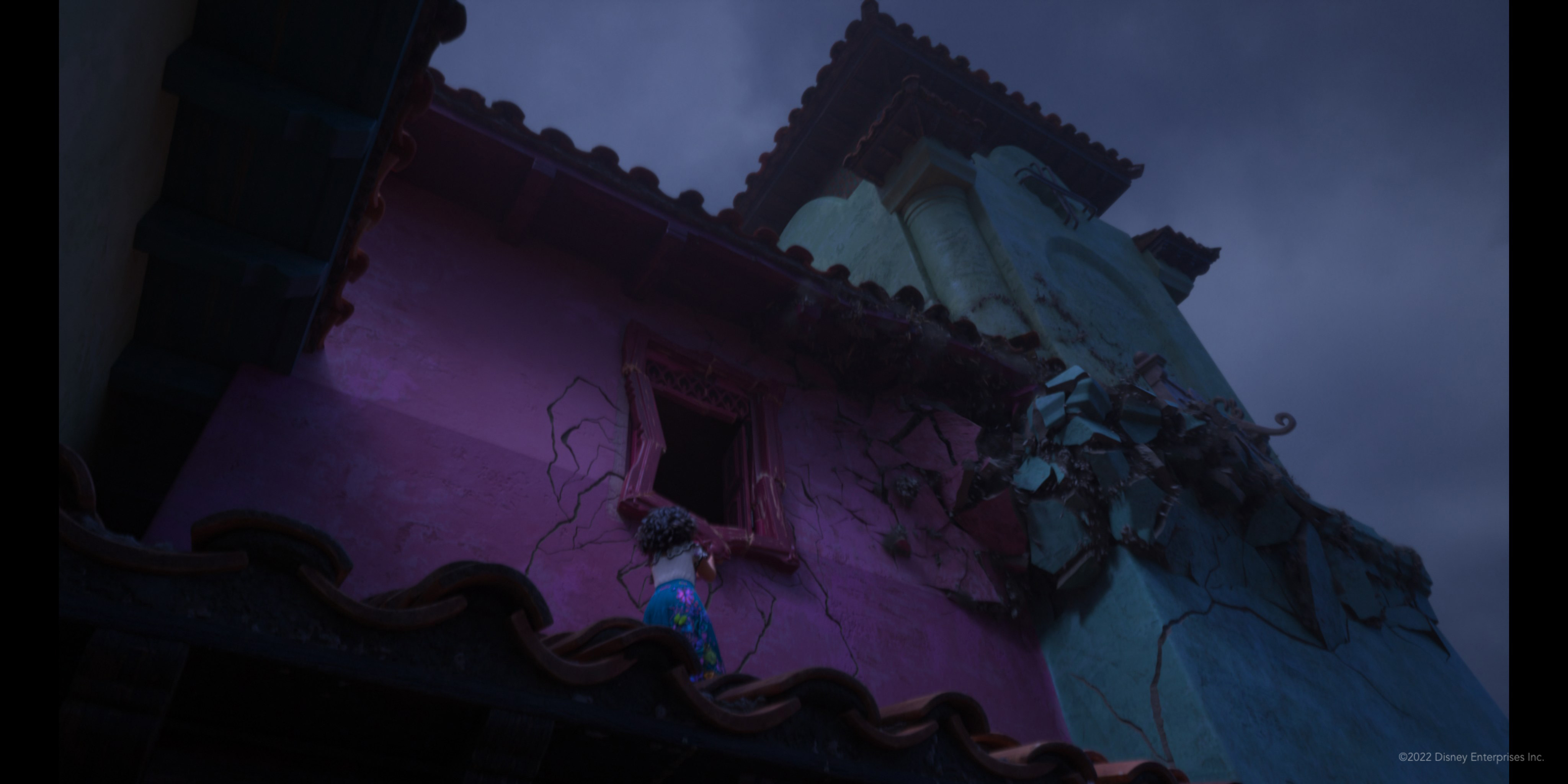
The Disney effects team collaborated closely with the studio’s layout team to choreograph cameras for timing and character animation. “Layout artists blocked cracks in walls, ceilings and floors using temporary crack elements generated by the effects department,” said effects lead Frankie Rodriguez. “Effects artists replaced these elements by hand-drawing low-resolution curves that were resampled and reshaped to the detail required by the shot. Crack progression in shots was achieved by using directly keyframed action or solvers with a few input variables. We then extruded these curves to create cutter planes, which we used to fracture sections of the house.”
In order to deform fragment edges and create the crack openings, artists derived vectors from the volume gradient of the fragments. Particle and volumetric simulations provided extra detail, with the fracture-aware subdivision algorithm adding yet more detail to the crack interiors.
Fauxkeh and Flames
A powerful symbol of the Madrigal family’s special powers, Abuela’s magical candle flame appears many times throughout Encanto. The effect needed to convey the strength of the family and to flicker with a personality all its own. “The directors loved the look of bokeh,” said effects lead Dale Mayeda, “which is a photographic lens effect that occurs when there is shallow focus and distant bright points of light which blur into a variety of shapes depending on the lens used.”
Having studied the many shapes and patterns evident in various forms of bokeh, the Disney effects team created a magical effect that was unrestricted by depth or camera – dubbed ‘fauxkeh.’ “We created four animated shape textures in Nuke,” Mayeda related. “One was a sharp circular shape with bright outer ring, and another had a bright soft center core over a broad soft shape. We also had a soft circular shape with chromatic aberration on the edges and an animated glint.”
Artists implemented the textures as sprites emanating from the magical candle flame, animating each texture on then softening and blurring it off over time. “It looked deceptively simple,” commented Mayeda, “but a fair amount of complexity was nuanced in the shader that added animated textural details, softness, color control and shimmer based on the fauxkeh’s behavior.” The fauxkeh derived its initial color from the flame, the color and brightness of which affected the particles near the source. Specific parts of the texture cycles then evolved and changed the appearance depending on the movement of the flame.
Because the effect was seen frequently throughout the film, the team outfitted the rig with robust controls enabling the effects animator to convey the correct emotion. “The balance of fauxkeh shapes could be adjusted depending on the tone of the shot,” said Mayeda. “It might need to bloom brightly with excited motion during celebration, sputter when things were darker, or look sickly when the magic was in danger.”
For the magical flame itself, the effects team developed a technique to accommodate the fact that the candle often moves quickly and erratically from place to place. Artists generated the initial pyro simulation with the candle wick positioned at the origin. “Trying to simulate it in the actual candle location required heavy sub-steps and also gave it an undesirable appearance as it moved around,” Mayeda noted. “We applied inverted velocities from the candle motion to give the feeling of the flame traveling through space, then moved the flame back to the traveling candle.”
In addition, the team needed to art-direct the colors and shape of the flame. “We used temperature to create the base shape with warm colors controlled with a color ramp,” explained Mayeda. “We also wanted the flame to have a lower transparent core with a blue fringe that mixed into the warm part of the flame. In order to have that art-directable control, we manipulated a small, tight SDF from the temperature field, used in VOPs to precisely define that transparent core and color balance between the warm and cool regions. We gave the effects animators additional controls to convey emotion by adding in turbulence and velocities to allow for bursts and flicker.”
Magical Doors
When each Madrigal child comes of age, a door in the Casita swirls with magical energy. When the child touches the doorknob, a flare of bright magic transforms the door into a richly carved glowing depiction of the person with their new magical gift. “Conceptually, we wanted the pre-transformation door to show swirling magic with no specific indication of what gift the magic might impart,” said effects animator Bruce Wright. “The mysterious swirl represents the unbounded possibility of what a child might pursue as their life’s goals.”
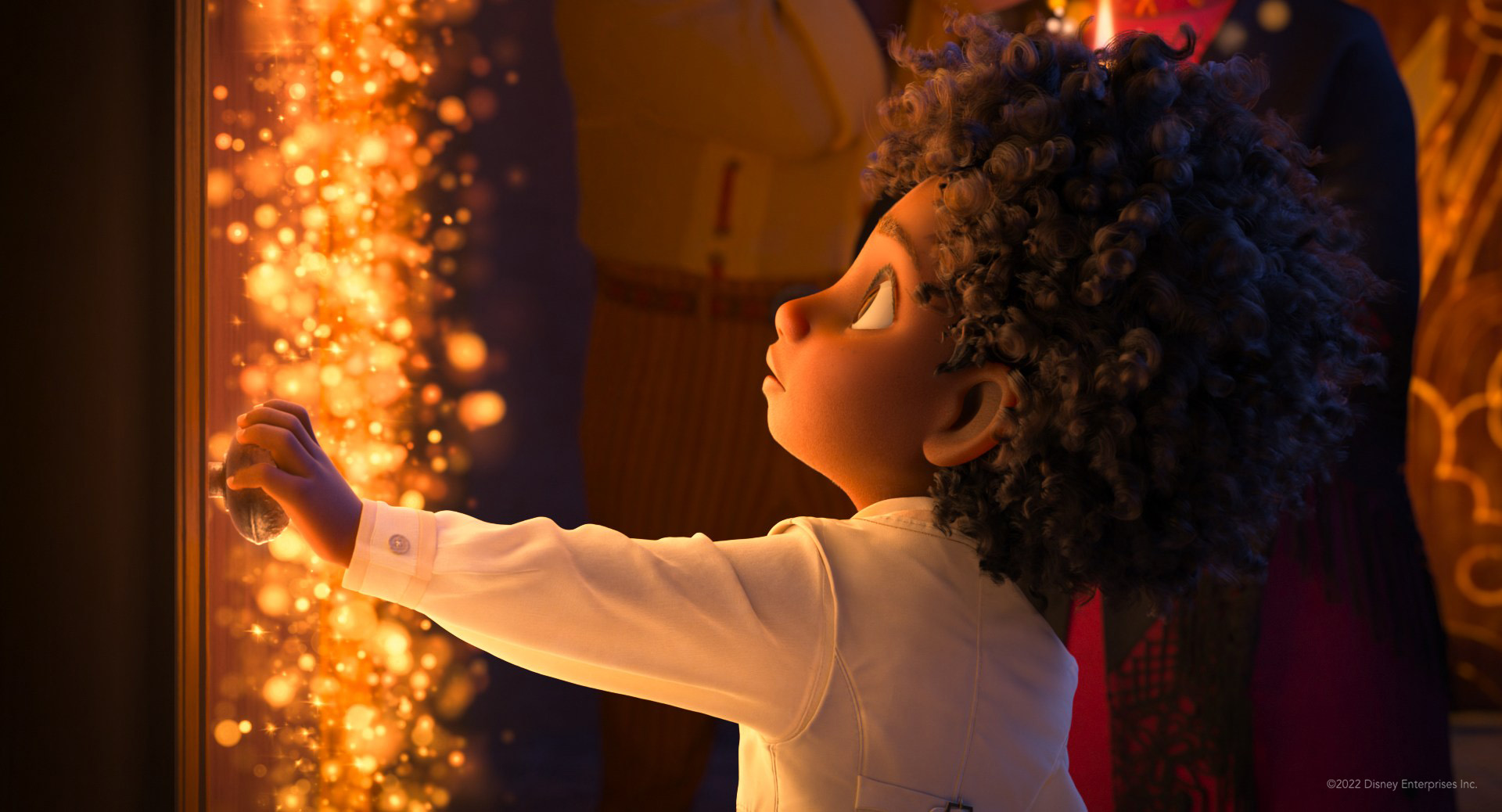
Effects animators began by drawing a distinctive curve for each door, with points instanced around it. “We used a solver to VDB advect the points around those shapes,” said Wright, “with Trail and Wire SOPs generating geometry from their motion. That geometry was then hidden and used as an emissive light source which illuminated the door with a gentle undulation caused by a curl noise. In addition, we emitted particles and fauxkeh from the door to ensure the audience connects the magic of the candle to the magic of the transforming doors.”
Kaleidoscope of Flowers
As Isabela performs her emotional song What Else Can I Do? an ever-changing tapestry of flower patterns transforms the walls of her bedroom into a vibrant kaleidoscope of color. Working closely with production designers Ian Gooding and Lorelay Bové, the effects team developed unique animations and shapes for each shot in the sequence.
“The positioning and motion of each design was carefully crafted to enhance the energy and composition of each shot,” said effects animator Peter DeMund, “as well as to underline different motifs and metaphors in the lyrics of the song. Once these animations and designs were finalized, we generated animated textures and handed them off to the look development team to control the generation and motion of the flower instances. The textures were split into three different passes in the RGB channels, allowing each channel to be used to drive different properties of the procedural effects.”
Shot-by-shot style frames established the appearance of the animated images on the walls. “The unwrapped wall geometry of Isabela’s room was huge compared to the small area within the camera view that needed an animated image,” said effects animator Jesse Erickson. “Because the camera was constantly moving, the unwrapped canvas area needing animated images functioned like a small spotlight traveling across the walls. The animated designs existed only within that small, moving area.”
To identify the area where animation was needed, the camera’s frustum edges and a camera-projected render were baked to a UV texture for each scene, viewed in context as placed upon the full-wall geometry. “We animated the subsequent floral graphics in Nuke,” Peter DeMund related. “Based on the color-keys, we divided the design elements in each shot into RGB channels for 2D output. These channels were later used in Disney’s XGen to drive different properties and to control the final material colors. We previewed the animation as a UV texture in Houdini and showed it to the directors through the frustum frame. Once approved, it was then baked as an animated Ptex texture sequence in Houdini for consumption by Disney’s XGen to generate the animated flower instances.”
For the pivotal shot of Isabela’s giant figure appearing on the floral wall behind her projection, artists working in Houdini used Hyperion render outputs from a modified scene camera. “We projected this render back through the original scene camera to accomplish the crash zoom projection effect when the camera pulled back,” explained Jesse Erickson. “We processed the render outputs further in a Houdini shader and ran them through the same texture baking process to get the various passes into the Ptex sequences in order to drive different procedural effects.”
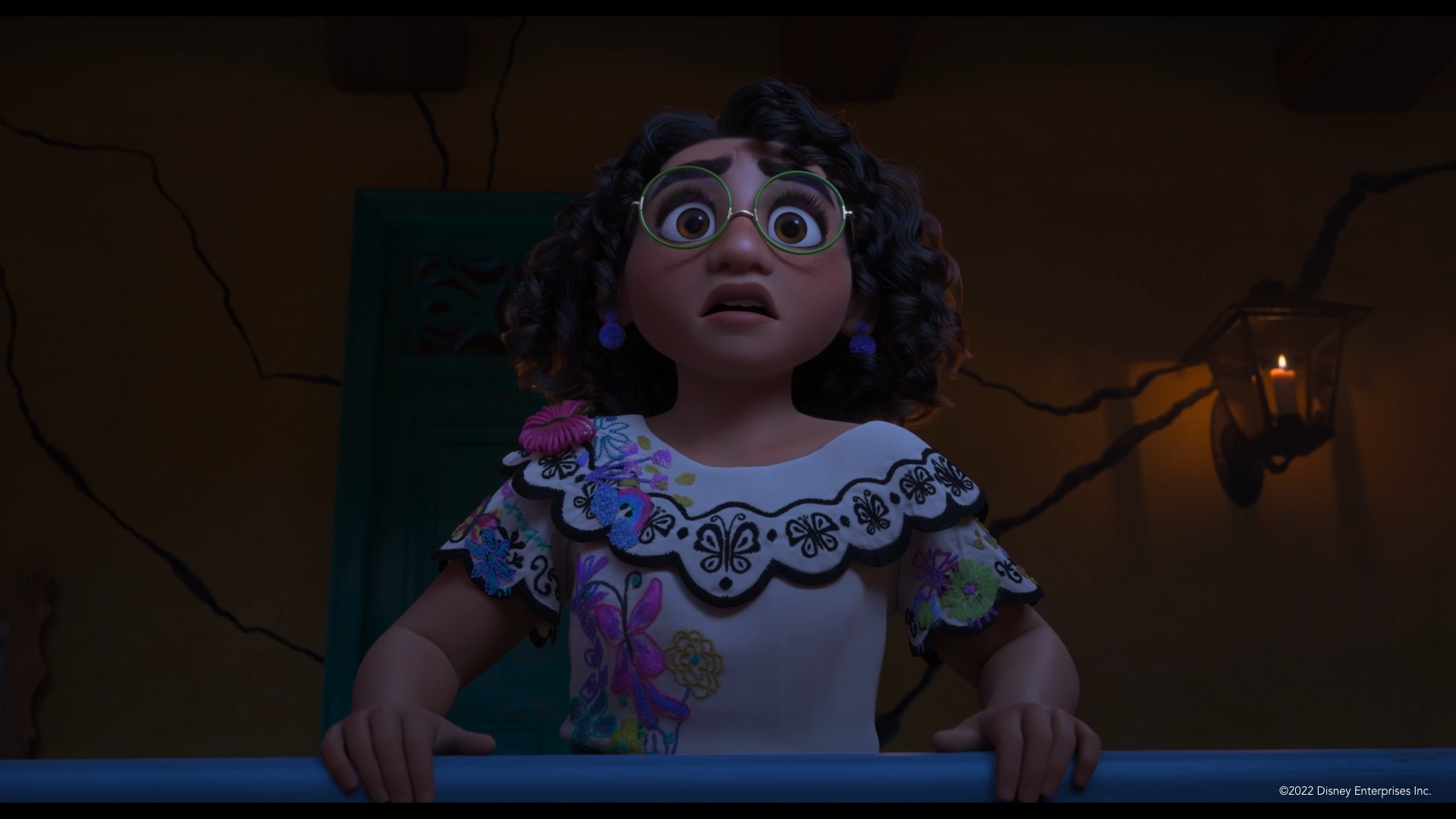
COMMENTS
David Inlines 2 years, 1 month ago |
Very nice!! Super awesome work!
timf81b9a446d8d4241 2 years, 1 month ago |
Nice!
ValikoUA 2 years ago |
I love watching Encanto with my daughter and I really like how it is made. Belissimo! Beautiful!
mayuhong 2 years ago |
Awesome work.
3dkeshaw 2 years ago |
wow
Birendra 2 years ago |
I am really excited to be part of the beautiful journey! Amazing work as always...
traileverse 1 year, 6 months ago |
turning those fractured pieces into SDFs and using the gradient vector to displace the pieces to create the crack just opened up a whole new workflow for me! LOL, it's so simple and cool.
Please log in to leave a comment.